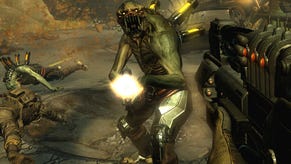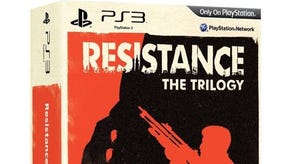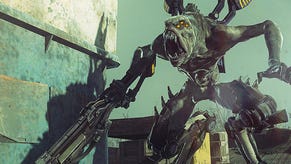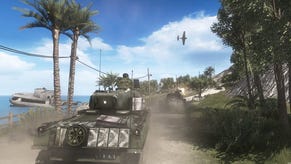Resistance 3
Judgment day.
Do you like single-player campaigns? I like single-player campaigns, and on the evidence of Resistance 3, Insomniac Games likes single-player campaigns. At a time when more and more shooters are seeing their story modes shrink in size and importance, used only to introduce the assets you'll be seeing online, the robust solo portion of Resistance 3 is a welcome return to the days when the campaign mode was the main course, not the appetiser.
It also feels very different to the previous games in the series, perversely ditching the aggressive militarism which is now so in vogue in FPS circles in favour of a more sombre tale. This is no longer a war game. The alien invasion that raged through the first two games (and one PSP spin-off) is all but over. Less than ten per cent of humanity remains alive and in hiding, and the Chimera are ruthlessly scouring the globe, exterminating survivors.
In the midst of this grim scenario we find Joe Capelli, a soldier dishonourably discharged after spoilery events at the end of Resistance 2. When we meet him, he's living in a makeshift refugee camp in Oklahoma with his wife and four-year-old son. When the Chimera arrive, his family flees into the wasteland, leaving Joe to cling to one last hope: that the fact the Chimera are channelling huge amounts of energy to New York means there's something important there that can end their brutal occupation.
Structurally, it's like a post-apocalyptic road movie. This gives the game the freedom to introduce (and discard) new locations and new groups of characters as Joe makes his way towards the East Coast. Like the Littlest Hobo with firearms, he stumbles into various human enclaves, helps them with their problems and is pushed a few hundred miles closer to his goal by their gratitude.
Even in levels filled with explosions and firefights, the melancholy mood remains. There's a general sense of hopelessness to the story that sets it apart from the chest-beating that typifies a blockbuster shooter. Joe is a doubting, desperate man. The people he meets are clearly doomed, if not during his encounter, then surely some time after he leaves.
In most levels, the genre beats skew closer to horror than to the expected sci-fi or action. Lots of games make use of the imagery of desolate Americana, but Resistance 3 never makes its setting self-consciously cool. A sequence in which you take a slow boat ride through a flooded town is downright eerie, with obvious (and presumably deliberate) echoes of post-Katrina New Orleans. This is a game that knows that quiet can be just as effective as sound and fury.
But for all its downbeat strokes, Resistance 3 is very much a shooter - and as with its predecessors, its weaponry defines it. Once again swimming against the tide of FPS design, the two-gun limit popularised by Halo has been cast aside in favour of a persistent 12-weapon selection which gradually fills out over the course of the story.
Old favourites like the Auger, Bullseye and high-explosive Magnum return; combined with dependable genre staples like a rocket launcher, sniper rifle and shotgun, they provide a flexible arsenal that serves multiple play styles. Added to these are outlandish newcomers such as the Mutator, which fires sticky gobs of mutagenic slime that transforms enemies into pustulent, exploding meatbags, a freeze-ray Cryogun, and the Atomizer, which disintegrates enemies up close.

Secondary fire is one area where Insomniac has set Resistance apart, and that trend continues here. The Mutator can lob gas canisters that leave anyone caught in their range vomiting themselves to death. The Atomizer deploys an energy vortex that ensnares all nearby enemies and churns them into quantum mincemeat. The Cryogun has a recharging pulsewave that shatters frozen enemies.
All are huge fun to play around with, and their usefulness is now augmented by a simple levelling system. The more you use a particular weapon, the stronger it becomes. Every weapon has a further two enhancements that can be unlocked in this fashion, a welcome twist that expands your combat options yet further. We've become so accustomed to the claustrophobic, prescriptive nature of shooters that returning to a game that lets you pile your plate from a whole buffet table of carnage is liberating.
With recharging shields excised in favour of finite health and sporadic medpacks, that flexibility is constantly put to the test. Time and again you'll find situations where progress comes from quick thinking and experimentation rather than bull-headed persistence.









